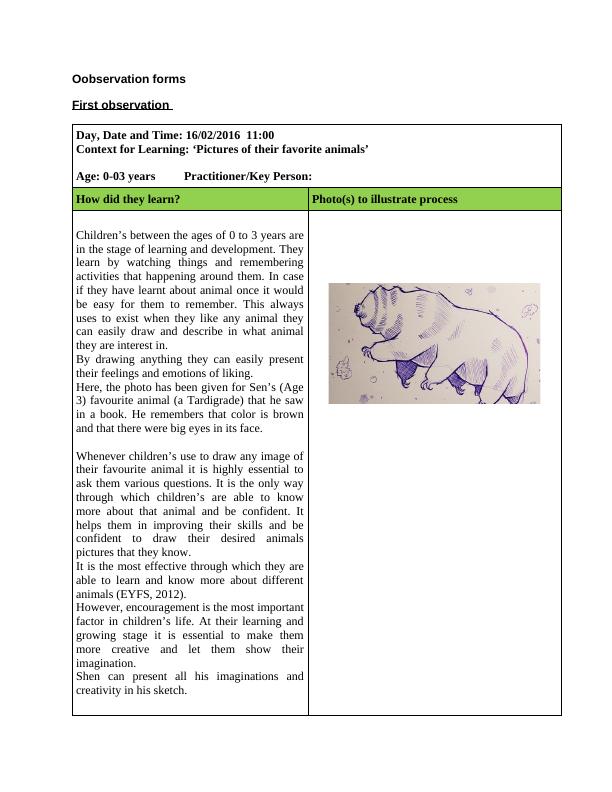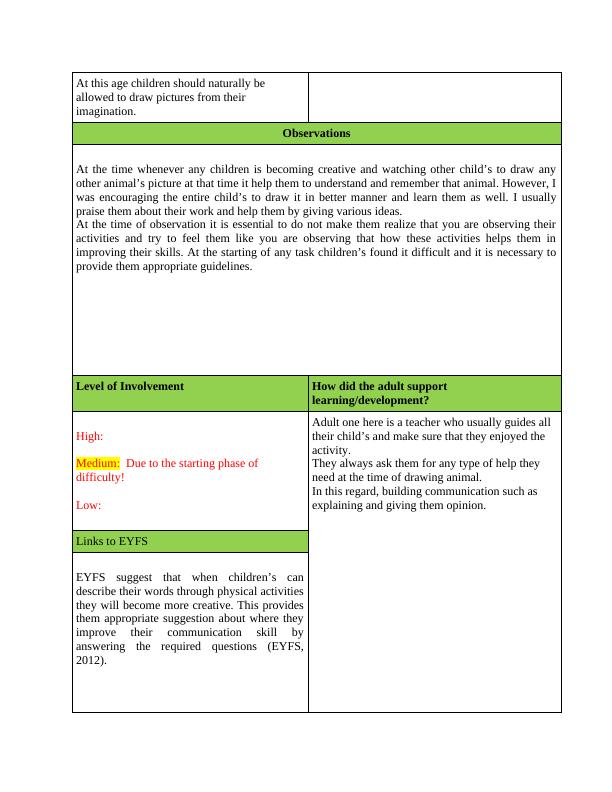Observation Forms for Early Childhood Development
Added on 2023-04-22
19 Pages3272 Words481 Views
Oobservation forms
First observation
Day, Date and Time: 16/02/2016 11:00
Context for Learning: ‘Pictures of their favorite animals’
Age: 0-03 years Practitioner/Key Person:
How did they learn? Photo(s) to illustrate process
Children’s between the ages of 0 to 3 years are
in the stage of learning and development. They
learn by watching things and remembering
activities that happening around them. In case
if they have learnt about animal once it would
be easy for them to remember. This always
uses to exist when they like any animal they
can easily draw and describe in what animal
they are interest in.
By drawing anything they can easily present
their feelings and emotions of liking.
Here, the photo has been given for Sen’s (Age
3) favourite animal (a Tardigrade) that he saw
in a book. He remembers that color is brown
and that there were big eyes in its face.
Whenever children’s use to draw any image of
their favourite animal it is highly essential to
ask them various questions. It is the only way
through which children’s are able to know
more about that animal and be confident. It
helps them in improving their skills and be
confident to draw their desired animals
pictures that they know.
It is the most effective through which they are
able to learn and know more about different
animals (EYFS, 2012).
However, encouragement is the most important
factor in children’s life. At their learning and
growing stage it is essential to make them
more creative and let them show their
imagination.
Shen can present all his imaginations and
creativity in his sketch.
First observation
Day, Date and Time: 16/02/2016 11:00
Context for Learning: ‘Pictures of their favorite animals’
Age: 0-03 years Practitioner/Key Person:
How did they learn? Photo(s) to illustrate process
Children’s between the ages of 0 to 3 years are
in the stage of learning and development. They
learn by watching things and remembering
activities that happening around them. In case
if they have learnt about animal once it would
be easy for them to remember. This always
uses to exist when they like any animal they
can easily draw and describe in what animal
they are interest in.
By drawing anything they can easily present
their feelings and emotions of liking.
Here, the photo has been given for Sen’s (Age
3) favourite animal (a Tardigrade) that he saw
in a book. He remembers that color is brown
and that there were big eyes in its face.
Whenever children’s use to draw any image of
their favourite animal it is highly essential to
ask them various questions. It is the only way
through which children’s are able to know
more about that animal and be confident. It
helps them in improving their skills and be
confident to draw their desired animals
pictures that they know.
It is the most effective through which they are
able to learn and know more about different
animals (EYFS, 2012).
However, encouragement is the most important
factor in children’s life. At their learning and
growing stage it is essential to make them
more creative and let them show their
imagination.
Shen can present all his imaginations and
creativity in his sketch.

At this age children should naturally be
allowed to draw pictures from their
imagination.
Observations
At the time whenever any children is becoming creative and watching other child’s to draw any
other animal’s picture at that time it help them to understand and remember that animal. However, I
was encouraging the entire child’s to draw it in better manner and learn them as well. I usually
praise them about their work and help them by giving various ideas.
At the time of observation it is essential to do not make them realize that you are observing their
activities and try to feel them like you are observing that how these activities helps them in
improving their skills. At the starting of any task children’s found it difficult and it is necessary to
provide them appropriate guidelines.
Level of Involvement How did the adult support
learning/development?
High:
Medium: Due to the starting phase of
difficulty!
Low:
Adult one here is a teacher who usually guides all
their child’s and make sure that they enjoyed the
activity.
They always ask them for any type of help they
need at the time of drawing animal.
In this regard, building communication such as
explaining and giving them opinion.
Links to EYFS
EYFS suggest that when children’s can
describe their words through physical activities
they will become more creative. This provides
them appropriate suggestion about where they
improve their communication skill by
answering the required questions (EYFS,
2012).
allowed to draw pictures from their
imagination.
Observations
At the time whenever any children is becoming creative and watching other child’s to draw any
other animal’s picture at that time it help them to understand and remember that animal. However, I
was encouraging the entire child’s to draw it in better manner and learn them as well. I usually
praise them about their work and help them by giving various ideas.
At the time of observation it is essential to do not make them realize that you are observing their
activities and try to feel them like you are observing that how these activities helps them in
improving their skills. At the starting of any task children’s found it difficult and it is necessary to
provide them appropriate guidelines.
Level of Involvement How did the adult support
learning/development?
High:
Medium: Due to the starting phase of
difficulty!
Low:
Adult one here is a teacher who usually guides all
their child’s and make sure that they enjoyed the
activity.
They always ask them for any type of help they
need at the time of drawing animal.
In this regard, building communication such as
explaining and giving them opinion.
Links to EYFS
EYFS suggest that when children’s can
describe their words through physical activities
they will become more creative. This provides
them appropriate suggestion about where they
improve their communication skill by
answering the required questions (EYFS,
2012).

Home Involvement
Learning can be done by making regular practice at home. It can be assessed by providing
homework to children’s at their homes. However, this is quite effective through which teacher can
involve the children’s at their homes as well.
Here, parents can teach them about different animals and communicate with the teacher that how
the child is developing at home. Parents can easily identify the problems of their children’s at
home.
Next Step (Possibly lines of Development)
Once child have completed the drawing there could be a discussion in group related to the carpet
such as why did they pick that animal?
Evaluation
The activity was quite impressive and most of the children have completed it in an effective way.
Sen were very creative. The EYFS (2012) says that children age 0-3 years “develop preferences for
forms of expression.
Name of child: child A Date:
Observer: Observation no:
Context: Time:
Making relationships Seen Observations
(What the child is doing or saying)
Learning can be done by making regular practice at home. It can be assessed by providing
homework to children’s at their homes. However, this is quite effective through which teacher can
involve the children’s at their homes as well.
Here, parents can teach them about different animals and communicate with the teacher that how
the child is developing at home. Parents can easily identify the problems of their children’s at
home.
Next Step (Possibly lines of Development)
Once child have completed the drawing there could be a discussion in group related to the carpet
such as why did they pick that animal?
Evaluation
The activity was quite impressive and most of the children have completed it in an effective way.
Sen were very creative. The EYFS (2012) says that children age 0-3 years “develop preferences for
forms of expression.
Name of child: child A Date:
Observer: Observation no:
Context: Time:
Making relationships Seen Observations
(What the child is doing or saying)

Does the child:
The child is not comfortable while working in a
group. He has further shown an inability to share
ideas. Neither does he wants to understand the rules.
However, the child is very good in forming
relationships but at the time of working as groups he
might become selfish sometimes just to highlight his
work. He is a very good listener and treats others
with full dignity and respect.
Form relationships yes
Take turns yes
Share fairly no
Work as part of a group no
Understand about rules no
Treat others with respect yes
Take into account idea
of others
no
Self-confidence and self-
awareness
The child is not comfortable to speak in a group
setting. He avoids sharing ideas. It takes time for him
to sort out the problems. There is also a lack of
concentration in him followed by a feeling of being
less involved Most of the time he feels motivated and
work hard to get involved with others. He is very
confident in his area of field and gives his best to
perform effectively.
Is the child:
Interested yes
Speaking in a group No
Solving problems No
Motivated yes
Concentrating no
Persevering no
Independent yes
Involved No
Confident yes
Initiating ideas no
Independent yes
Does the child:
The child is not comfortable while working in a
group. He has further shown an inability to share
ideas. Neither does he wants to understand the rules.
However, the child is very good in forming
relationships but at the time of working as groups he
might become selfish sometimes just to highlight his
work. He is a very good listener and treats others
with full dignity and respect.
Form relationships yes
Take turns yes
Share fairly no
Work as part of a group no
Understand about rules no
Treat others with respect yes
Take into account idea
of others
no
Self-confidence and self-
awareness
The child is not comfortable to speak in a group
setting. He avoids sharing ideas. It takes time for him
to sort out the problems. There is also a lack of
concentration in him followed by a feeling of being
less involved Most of the time he feels motivated and
work hard to get involved with others. He is very
confident in his area of field and gives his best to
perform effectively.
Is the child:
Interested yes
Speaking in a group No
Solving problems No
Motivated yes
Concentrating no
Persevering no
Independent yes
Involved No
Confident yes
Initiating ideas no
Independent yes
Does the child:

End of preview
Want to access all the pages? Upload your documents or become a member.
Related Documents
Writing Teaching Resourceslg...
|3
|537
|47
Plan for Babies: Slow Version of Shell Game and Plan for Toddlers: Sorting Shapeslg...
|7
|1562
|483
Assessment Planning and Observations in Early Education Frameworklg...
|6
|1186
|235
Sociocultural Tables - Cognitive Development in Childrenlg...
|7
|989
|290
Learning Disabilities and Diagnosis of Dyslexia : Essaylg...
|14
|5389
|98
CHC50113: Integrated Workplace Assessment Task Activitieslg...
|77
|21539
|20
